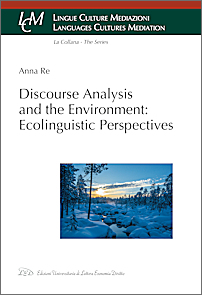LCM - La Collana / The Series - ISSN 2283-5628

Anna Re
DISCOURSE ANALYSIS AND THE ENVIRONMENT:
ECOLINGUISTIC PERSPECTIVES
ISBN 978-88-5513-158-2 - https://doi.org/10.7359/1582-2024-re-ecolinguistic
pp. 110 - 2024 - € 24,00 (-15%) ![]() € 20,40
€ 20,40
The aim of this volume is to verify how the concepts conveyed by the keywords wilderness and wildness have varied in recent years with respect to their original/ literal meanings, as well as the effects these changes may have on discourse about the environment and the protection of remaining wild lands. The words have been chosen because they thoroughly conceptualize the idea of untamed nature and can help shed light on beneficial environmental discourses. The reference framework of this work is ecolinguistics in its attempt to determine how environmental issues are discussed and narrated; and its rationale is that of combining corpus linguistics with narrative and discursive use analyses. Association of these methods can heighten the results and offer new tools for ecolinguistics scholars. The analysis displays many occurrences of wilderness and very few of wildness that nuance various meanings in the SibBol corpus and in The Guardian sub corpus, reflecting differing reference contexts. Wilderness largely keeps its literal meaning, compared to a broader meaning associated with wildness which is connected with qualities that can be dissociated from nature. The term is progressing toward a metaphorical meaning, as its discursive usage demonstrates. Instead, the wilderness discourse – whether in articles, books, social media or documentaries – can play a pivotal role in wilderness conservation by educating the public, influencing policy, engaging communities, building emotional connections, documenting issues, and promoting sustainable practices. The success of conservation efforts hinges on communication through various forms of written and spoken words.
Anna Re is a senior researcher in English Linguistics and Translation (L-LIN/12) at IULM University – International University of Languages and Media (Milano). Her research focuses on ecolinguistics, discourse analysis, American environmental literature, and the translation and teaching of English language within the Italian milieu. Among her publications, Italian Environmental Literature: An Anthology (2004), Americana Verde (2009 and 2017), English & the Arts: A Contemporary Romance. Language, Style, Genres (2019).
![]()
Introduction
1. Definition and conceptualization of the keywords: wildness & wilderness
1.1. Wildness (p. 14) – 1.2. Wilderness (p. 17) – 1.2.1. Wilderness and the United States (p. 19) – 1.2.2. Urban wilderness (p. 21) – 1.2.3. Restored wilderness (p. 23) – 1.3. Secondary nature (p. 24)
2.1. Ecolinguistics and the search of a method (p. 27) – 2.2. Cor-pus-assisted ecolinguistic analysis (p. 30) – 2.3. Narrative analysis (p. 33) – 2.4. Discursive use analysis (p. 35)
3. An ecolinguistic corpus-assisted and discourse analysis of the SiBol corpus (1993-2021)3.1. “The English language newspapers corpus” and the tools used in the analysis (Word Sketch, Word Sketch Difference, Thesaurus, Concordance) (p. 37) – 3.2. Wildness & wilderness collocations (p. 38) – 3.3. Wildness/wilderness synonyms (p. 62) – 3.4. Wilderness/wildness “conservation/biodiversity” discourses (p. 64) – 3.4.1. Con-servation (p. 66) – 3.4.2. Biodiversity (p. 68) – 3.5. Final considera-tions (p. 70)
4.1. Range of articles in The Guardian (p. 76) – 4.2. Analysis of the articles (p. 77) – 4.3. Editorial features analysis (p. 80) – 4.4. Structure and language analysis (p. 80) – 4.5. Discursive use (p. 86) – 4.6. Final considerations (p. 92) – 4.7. The wildness and wilderness articles of the sub corpus (p. 93) – 4.7.1. Wildness (p. 93) – 4.7.2. Wilderness (p. 95)






